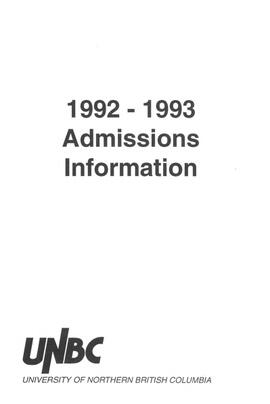Title and statement of responsibility area
Title proper
General material designation
Parallel title
Other title information
Title statements of responsibility
Title notes
Level of description
Reference code
Edition area
Edition statement
Edition statement of responsibility
Class of material specific details area
Statement of scale (cartographic)
Statement of projection (cartographic)
Statement of coordinates (cartographic)
Statement of scale (architectural)
Issuing jurisdiction and denomination (philatelic)
Dates of creation area
Date(s)
-
1988-2019 (Creation)
- Creator
- University of Northern British Columbia
Physical description area
Physical description
- 24 cm of textual records
- 216 photographs
- 5 objects
- 1 video recording
Publisher's series area
Title proper of publisher's series
Parallel titles of publisher's series
Other title information of publisher's series
Statement of responsibility relating to publisher's series
Numbering within publisher's series
Note on publisher's series
Archival description area
Name of creator
Administrative history
The UNBC story began in January 1987, at a public meeting, held at the College of New Caledonia, on the possibility of extending degree-awarding opportunities in Prince George and on December 1, 1987, the Interior University Society (IUS) was incorporated under the Societies Act.
Important early support for the IUS was obtained from Bruce Strachan, MLA for Prince George South and Minister of State for the Cariboo Region, who saw the regional development potential of a northern university. This led to the commissioning of a study Building a Future of Excellence: a University of Northern BC ("The Dahloff Report"). On October 13, an IUS delegation was able to present the government with:
a petition signed by 16,000 voters who had paid $5 for the privilege;
letters of support from every town, village, city, regional district, hospital board, school board and Chamber of Commerce in northern BC;
an Angus Reid survey which indicated that 94% of northerners were in favour of creating the university;
the Dahloff Report indicating the feasibility, credibility and value of the university.On November 1, 1989 the Government announced that Bruce Strachan, a clear advocate of the university of the north, had been appointed Minister of Advanced Education. On January 9, Minister Strachan made a formal statement that the government had accepted the IPG recommendations: that a university was to be established in the north with a main campus in Prince George. On June 22, the Provincial Legislature passed Bill 40, The UNBC Act, with all-party support. The Interim Governing Council then met formally for the first time on July 21. It was to act as both Board and Senate until such time as the University had gained the officers, faculty, and students capable of forming a senate.
Two dominant themes of early deliberations were site selection and the Presidential search. The latter began in June, and seven interviews were held in August and September. The outcome was the appointment of Geoffrey Weller, previously Vice-President Academic of Lakehead University. The IGC's site selection committee, meanwhile, had initially considered fifteen sites, but these were reduced to a shortlist of six sites for detailed study, and the Cranbrook Hill site finally carried the day when crown acreage was located with a fine view of the City.
In February 1992, the model of the Prince George campus was first unveiled, and in March, members of Convocation elected the University's first Chancellor, Iona Campognolo. The signing of the Memorandum of Understanding between UNBC and Forestry Canada occurred 3 July 1992 at the Coast Inn of the North in Prince George, BC. The MOU resulted in the establishment of UNBC's first research centre. The full opening of the University was delayed from September 1993 to September 1994. April saw the official sod-turning ceremony for the Prince George campus, conducted by BC Premier Mike Harcourt. This was followed in May with the largest and most prestigious event in the University's history to date - the Inaugural Convocation Ceremony, at which the formal Installation of the President and Chancellor took place. August 1992 saw the registration of the University's first students, when 70 students joined the "QuickStart" program. In November, interviews began for the appointment of the first 40 faculty members.
1994 saw the culmination of the years of planning and effort. In May, the first UNBC students graduated: six students from the "Quickstart" program received their degrees from the Governor General. In August, the Prince George campus was ceremonially opened by Her Majesty the Queen, at a nationally televised event which saw some 10,000 people visit the Prince George campus. In September, the University opened fully, with around 1,500 students enrolled. To commemorate the opening, a full-colour coffee-table book, "A University is Born", was published by the UNBC Press.
Custodial history
Scope and content
Collection consists textual material, objects, and ephemera related to the history of the University of Northern British Columbia.
Notes area
Physical condition
Immediate source of acquisition
Arrangement
Language of material
English
Script of material
Location of originals
Availability of other formats
Restrictions on access
Some restrictions apply.
Terms governing use, reproduction, and publication
Personal or academic use of materials is welcomed under the standard fair dealing and educational use clauses of Canadian Copyright Law. Commercial use is, however, forbidden without the express permission of the copyright holder. For information on obtaining written permission from the copyright holder, please contact the Northern B.C. Archives and Special Collections.
Finding aids
Associated materials
Accruals
Alternative identifier(s)
Standard number
Standard number
Access points
Subject access points
Place access points
Name access points
- University of Northern British Columbia (Subject)

